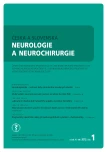Recanalization of Acute Occlusions of Cerebral Arteries Using a Retrievable Stent
Authors:
A. Krajina 1; V. Chovanec 1; D. Krajíčková 2; Miroslav Lojík 1
; J. Raupach 1; T. Česák 2; Z. Špriňar 1; R. Taláb 2; P. Ryška 1; V. Dostálová 3; O. Renc 1; S. Řehák 4
Authors‘ workplace:
LF UK a FN Hradec Králové
Radiologická klinika
1; LF UK a FN Hradec Králové
Neurologická klinika
2; LF UK a FN Hradec Králové
Klinika anesteziologie, resuscitace a intenzivní medicíny
3; LF UK a FN Hradec Králové
Neurochirurgická klinika
4
Published in:
Cesk Slov Neurol N 2012; 75/108(1): 75-79
Category:
Short Communication
Overview
Purpose:
To describe the effectiveness of a retrievable stent for mechanical thrombectomy in patients with acute ischemic stroke.
Materials and methods:
A retrospective, single-center study included 12 patients with embolic occlusion of large arteries treated according to the mechanical thrombembolectomy protocol. The patients were treated between 2009 and 2011. A selfexpandable and retrievable stent was used for revascularization in all patients (8 women and 4 men of mean age of 63.3 years). There were embolic occlusions of the M1 segment in 11 patients, in combination with occlusion of the internal carotid artery in two of them and one occlusion of the A2 segment of the anterior cerebral artery. The median NIHSS was 17. Thrombembolectomy with retrievable stent was used as a rescue therapy in 3 patients treated with Merci retriever.
Results:
Successful recanalization of TIMI 2 and 3 was achieved in all 12 patients with additional reopening of extracranial internal carotid arteries. One stent was deployed at the level of embolic occlusion after two failed attempts to remove a clot from A2 segment. Symptomatic intracranial hemorrhage was found in two patients. Three months after the therapy, 75% of patients were independent (mRS ≤2).
Conclusions:
Our results show that the retrievable selfexpandable stent can safely and rapidly retrieve clots from intracranial arteries.
Key words:
stroke – mechanical thrombembolectomy – cerebral revascularization – angiography
Sources
1. Nogueira RG, Liebeskind DS, Sung G, Duckwiler G, Smith WS. Predictors of good clinical outcomes mortality, and successful revascularization in patiens with acute ischemic stroke undergoing thrombectomy. Pooled analysis of the mechanical embolus removal in cerebral ischemia (MERCI) and Multi MERCI Trials. Stroke 2009; 40(12): 3777–3783.
2. The Penumbra Pivotal Stroke Trail Investigators. The Penumbra pivotal stroke trial: safety and effectiveness of a new generation of mechanical device for clot removal in intracranial large vessel occlusive disease. Stroke 2009; 40(8): 2761–2768.
3. Krajina A, Krajíčková D, Lojík M, Chovanec V, Raupach J, Kubíková M et al. Endovaskulární rekanalizace při léčbě akutních uzávěrů mozkových tepen. Cesk Slov Neurol N 2010; 73/106(6): 678–684.
4. Sauvageau E, Samuelson RM, Levy EI, Jeziorski AM, Mehta RA, Hopkins LN. Middle cerebral artery stenting for acute ischemic stroke after unsuccessful Merci retrieval. Neurosurgery 2007; 60(4): 701–706.
5. Jahan R. Solitaire flow-restoration device for treatment of acute ischemic stroke: safety and recanalization efficacy study in a swine vessel occlusion model. AJNR Am J Neuroradiol 2010; 31(10): 1938–1943.
6. Kelly ME, Furlan AJ, Fiorella D. Recanalization of an acute middle cerebral artery occlusion using a self--expanding, reconstrainable, intracranial microstent a temporary endovascular bypass. Stroke 2008; 39(6): 1770–1773.
7. Hauck EF, Mocco J, Snyder KV, Levy EI. Temporary endovascular bypass: a novel treatment for acute stroke. Am J Neuroradiol 2009; 30(8): 1532–1533.
8. Castaño C, Dorado L, Guerrero C, Millán M, Gomis M, Perez de la Ossa N et al. Mechanical thrombectomy with the Solitaire AB Device in large artery occlusions of the anterior circulation. Stroke 2010; 41(8): 1836–1840.
9. Liebig T, Reinartz J, Hannes R, Miloslavski E, Henkes H. Comparative in vitro study of five mechanical embolectomy systems: effectiveness of clot removal and risk of distal embolization. Neuroradiology 2008; 50(1): 43–52.
10. Ribo M, Rubiera M, Pagola J, Rodriguez-Luna D, Meler P, Flores A et al. Bringing forward reperfusion with oxygenated blood perfusion beyond arterial occlusion during endovascular procedures in patients with acute ischemic stroke. Am J Neuroradiol 2010; 31(10): 1899–1902.
11. Loh Y, Jahan R, McArthur DL, Shi ZS, Gonzalez NR, Duckwiler GR et al. Recanalization rates decrease with increasing thrombectomy attempts. Am J Neuroradiol 2010; 31(5): 935–939.
12. Miteff F, Faulder KC, Goh ACC, Steinfort BS, Sue C, Harrington TJ. Mechanical thrombectomy with a self--expanding retrievable intracranial stent (Solitaire AB): experience in 26 patients with acute cerebral artery occlusion. Am J Neuroradiol 2011; 32(6): 1078–1081.
13. Roth C, Papanagiotou P, Behnke S, Walter S, Haass A, Becker C et al. Stent-assisted mechanical recanalization for treatment of acute intracerebral artery occlusions. Stroke 2010; 41(11): 2559–2567.
14. Nayak S, Ladurner G, Killer M. Treatment of acute middle cerebral artery occlusion with a Solitaire AB stent: preliminary experience. Br J Radiol 2010; 83(996): 1017–1022.
15. Mori T, Kazita K, Seike M, Nojima Y, Mori K. Successful cerebral artery stent placement for total occlusion of the vertebrobasilar artery in a patient suffering from acute stroke. J Neurosurg 1999; 90(5): 955–958.
16. Meyers PM, Schumacher HC, Alexander MJ, Derdeyn CP, Furlan AJ, Higashida RT et al. Performance and training standards for endovascular ischemic stroke treatment. Am J Neuroradiol 2010; 31(1): E8–E11.
Labels
Paediatric neurology Neurosurgery NeurologyArticle was published in
Czech and Slovak Neurology and Neurosurgery

2012 Issue 1
Most read in this issue
- Vertebroplasty – Treatment Option for Structurally Insufficient Vertebras
- Carpal Tunel Syndrome and Neurosurgeon – Experience after 2,200 Surgeries
- Guillain-Barré Syndrome in a Patient with a Renal Carcinoma – a Case Report
- Guidelines for Pharmacotherapy of Neuropathic Pain
